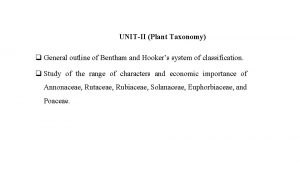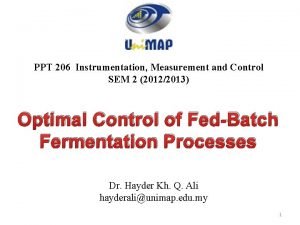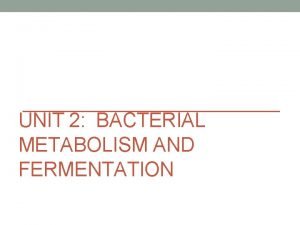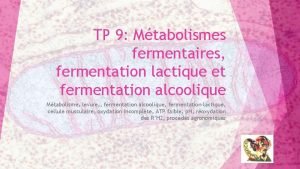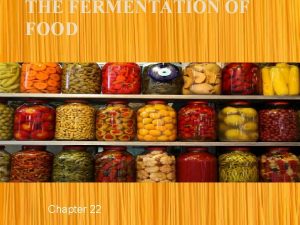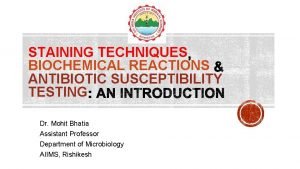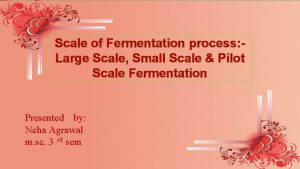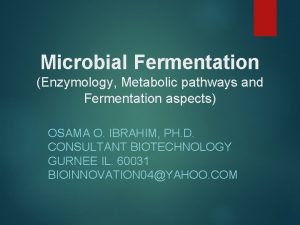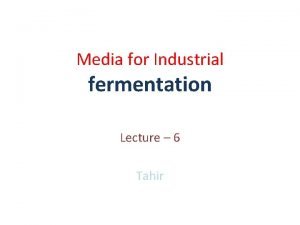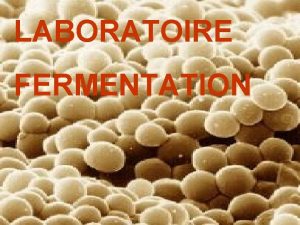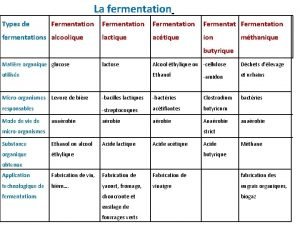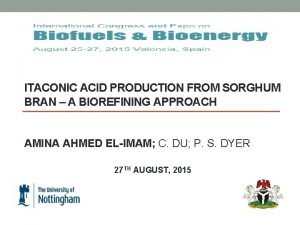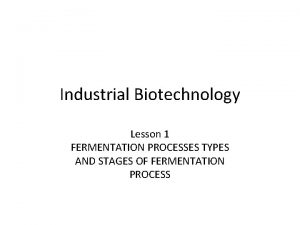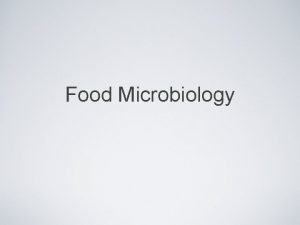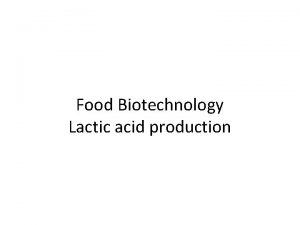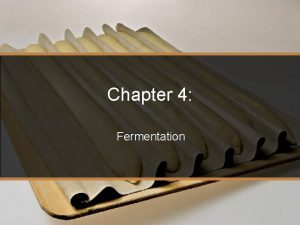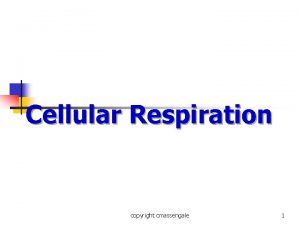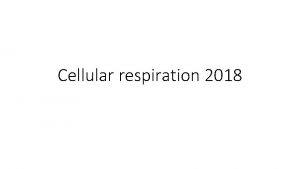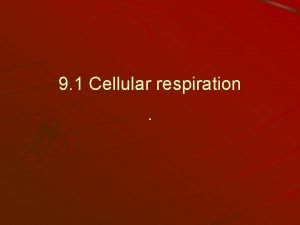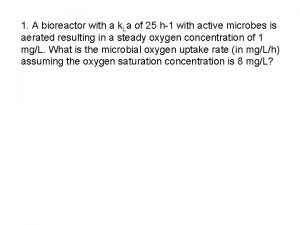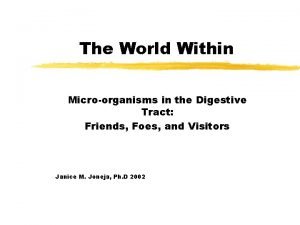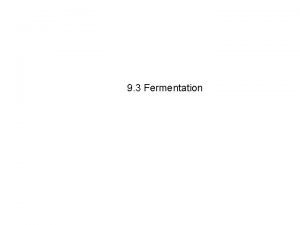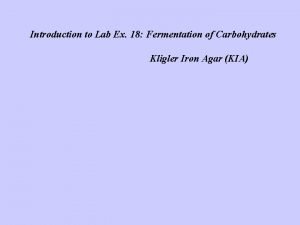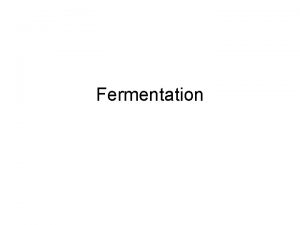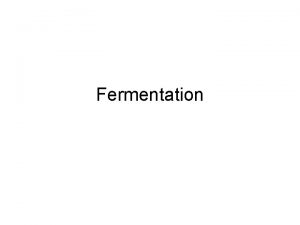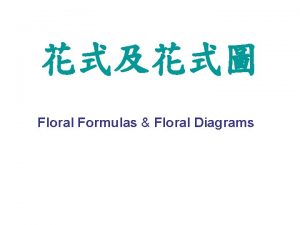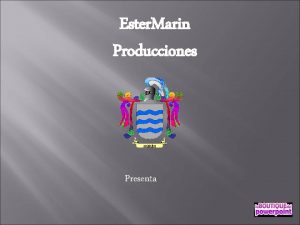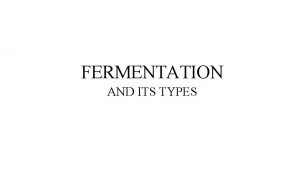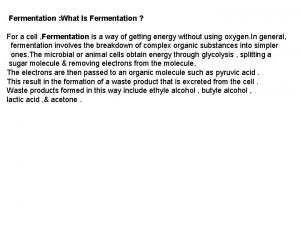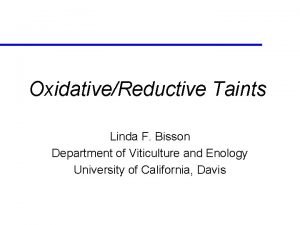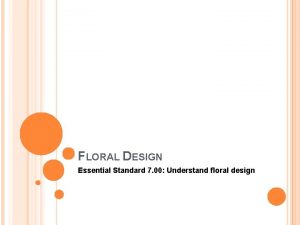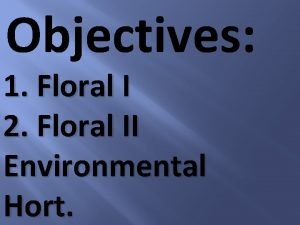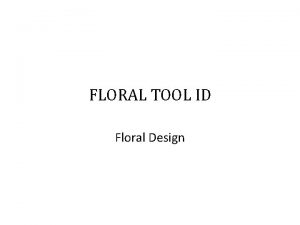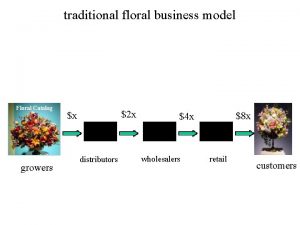Production of Fermentation Floral and Ester Taints Linda
































- Slides: 32

Production of Fermentation Floral and Ester Taints Linda F. Bisson Department of Viticulture and Enology University of California, Davis, CA

Outline of Presentation Introduction to Esters Ester Formation during Fermentation Stability of Esters

Introduction to Esters

What Is an Ester? Volatile molecule Formed from the reaction of an alcohol and a keto acid Formed enzymatically from an alcohol and a keto acid bound to the cofactor, Coenzyme A Characteristic fruity and floral aromas

Ester Formation O R 1 -OH + R 2 -C Co. A O R 1 -O-C-R 2

Where do Esters Come from? Can be formed by the chemical reaction of an alcohol and a keto acid Can be formed enzymatically by the plant Can be formed enzymatically by microbes

Where do Esters Come from in Wine? Can be formed by the chemical reaction of an alcohol and a keto acid Can be formed enzymatically by the plant Can be formed enzymatically by microbes – Non-Saccharomyces yeasts – Saccharomyces – Lactic acid bacteria – Acetic acid bacteria

Ester Classes Ethyl esters of acids Acetate esters of alcohols

Ester Classes Ethyl esters of acids – Keto acids from amino acid catabolism – Fatty acids from fatty acid biosynthesis or lipid degradation Acetate esters of alcohols – Ethanol – Derivatives from nitrogen metabolism » Fusel oils from amino acid catabolism » Alcohols from purine and pyrimidine catabolism

Common Esters Found in Wine Ethyl Propanoate Ethyl -2 -Methylpropanoate Ethyl-2 -Methylbutanoate Ethyl-3 -Methylbutanoate Isobutyl Acetate 2 -Methylpropyl Acetate 2 -Methylbutyl Acetate 3 -Methylbutyl Acetate (Isoamyl acetate) Hexyl Acetate – Requires grape precursor Ethyl Lactate – Bacterial in origin

Positive Wine Characters Associated with Esters Fruit – – – – – Apple Apricot Fig Melon Peach Pear Prune Raspberry Strawberry Honey Tropical fruit – – Banana Coconut Mango Pineapple Floral – Rose Butter Spice – vanilla Yeast (bread)

Esters Associated with Apple Amyl acetate Ethyl butyrate Isobutyl acetate Phenethyl acetate

Esters Associated with Pineapple Ethyl acetate Ethyl butanoate (Ethyl butyrate) Ethyl hexanoate

Esters Found in Chardonnay Ester Ethyl Acetate Ethyl Butyrate Isoamyl Acetate Hexyl Acetate Ethyl Hexanoate Ethyl Octanoate Ethyl Decanoate Concentration Range Across Strains (mg/L) 50 - 95 0. 4 - 0. 75 3. 5 - 11. 0 - 1. 7 1. 0 - 2. 2 1. 4 - 2. 0 0. 6 - 0. 9

Negative Wine Characteristics Associated with Esters Foxy Nail polish Bubble gum/cotton candy Soapy Candle wax Perfume Intense fruit Intense floral

Ester Expression Dependent upon chemical species present Dependent upon concentrations: relative and absolute Dependent upon matrix factors Dependent upon yeast strain and substrates

In General. . . The higher the concentration the more negative the impression is of the character Longer chain esters fall into soapy, perfume range Combinations of esters can confer a stronger aroma than the sum of the individual compounds

Negative Ester Characters Nail polish/glue: ethyl acetate Soap: ethyl octanoate, ethyl decanoate Perfume: hexyl acetate Rose: phenethylacetate, phenethyl alcohol

Esters Found in Chardonnay Ester Ethyl Acetate Ethyl Butyrate Isoamyl Acetate Hexyl Acetate Ethyl Hexanoate Ethyl Octanoate Ethyl Decanoate Concentration Range Across Strains (mg/L) 50 - 95 0. 4 - 0. 75 3. 5 - 11. 0 - 1. 7 1. 0 - 2. 2 1. 4 - 2. 0 0. 6 - 0. 9

Ester Formation During Fermentation

Ester Formation during Fermentation Influence of non-Saccharomyces yeasts Production by Saccharomyces

Production by Non-Saccharomyces yeast Grape flora Winery residents Primary genera: – Hanseniaspora (Kloeckera) – Metschnikowia (Candida) – Candida – Pichia – Torulaspora – Kluveromyces

Production by Non-Saccharomyces yeast Contribute generic fruity and floral notes Can make excessive ethyl acetate (Hanseniaspora) Better adapted to lower temperatures than Saccharomyces – Bloom during cold-settling – Bloom during cold maceration – Can be sulfite tolerant

Production by Saccharomyces Yeast Strain Nutrition (Sugar, Nitrogen) Generally increased nitrogen in vineyard increases ester concentrations – During fermentation impacted by both nitrogen source (NH 4+, amino acids) and nitrogen level interacting with yeast genetic background – Temperature Grape Variety

Ester Formation in Wines Vianna & Ebeler, 2001 J. Agric. Food Chem. , 49(2): 589 -595

Stability of Esters

Ester Loss Volatilization: – temperature dependent – fermentation vigor dependent Hydrolysis: – p. H dependent – time dependent Matrix effects: – masking: ethanol – enhancing: sugar, polyphenol, tannin

Ester Loss Generally lost upon aging in barrel (volatilization and hydrolysis) Lost upon aging in bottle (hydrolysis) Most esters gone six months postfermentation, depending upon aging and temperature of aging

Control of Ester Formation Management of strains and microbial populations Age under conditions favoring loss (or retention)

Ester Taint Tasting Glass 1: Control Chardonnay wine Glass 2: Ethyl acetate Glass 3: Ethyl octanoate, ethyl decanoate Glass 4: Hexyl acetate Glass 5: Phenethylacetate, phenethyl alcohol Glass 6: Rhône 4600 esters, Grenache blanc

Ester Taint Tasting Glass 1: Control Chardonnay wine Glass 2: Ethyl acetate: nail polish remover Glass 3: Ethyl octanoate, ethyl decanoate: soap Glass 4: Hexyl acetate: perfume Glass 5: Phenethylacetate, phenethyl alcohol: rose Glass 6: Rhône 4600 esters, Grenache blanc

Rhône 4600: Isolated from the Côtes du Rhône region Complex aroma notes and elevated ester production such as tropical (pineapple) and fresh fruit (apple, pear, strawberry)
 Carta alir proses pembuatan produk
Carta alir proses pembuatan produk Floral design pricing worksheet
Floral design pricing worksheet Metadata and taxonomy
Metadata and taxonomy Flower in plural form
Flower in plural form Difference between submerged and solid state fermentation
Difference between submerged and solid state fermentation Cellular respiration
Cellular respiration Measurement and control of fermentation parameters ppt
Measurement and control of fermentation parameters ppt Nutrition in bacteria
Nutrition in bacteria Fermentation alcoolique tp
Fermentation alcoolique tp Lactic acid fermentation sauerkraut
Lactic acid fermentation sauerkraut Mr test
Mr test Bench scale fermentation
Bench scale fermentation Classification of fermentation
Classification of fermentation Fenicilin
Fenicilin Types of fermentation
Types of fermentation Fermentation des glucides
Fermentation des glucides Types de fermentation
Types de fermentation Itaconic acid fermentation
Itaconic acid fermentation Fermentation ppt
Fermentation ppt Factors affecting fermentation
Factors affecting fermentation Factors affecting fermentation
Factors affecting fermentation P mirabilis lactose fermentation
P mirabilis lactose fermentation Alcoholic fermentation steps
Alcoholic fermentation steps Factors affecting fermentation
Factors affecting fermentation Exergonic cellular respiration
Exergonic cellular respiration Does fermentation occur in the mitochondria
Does fermentation occur in the mitochondria Formula for lactic acid fermentation
Formula for lactic acid fermentation Heterolactic fermentation pathway
Heterolactic fermentation pathway Fermentation lactique équation
Fermentation lactique équation Carbohydrates fermentation
Carbohydrates fermentation Fermentation in microorganisms
Fermentation in microorganisms Carbohydrates fermentation
Carbohydrates fermentation Carbohydrates fermentation
Carbohydrates fermentation


